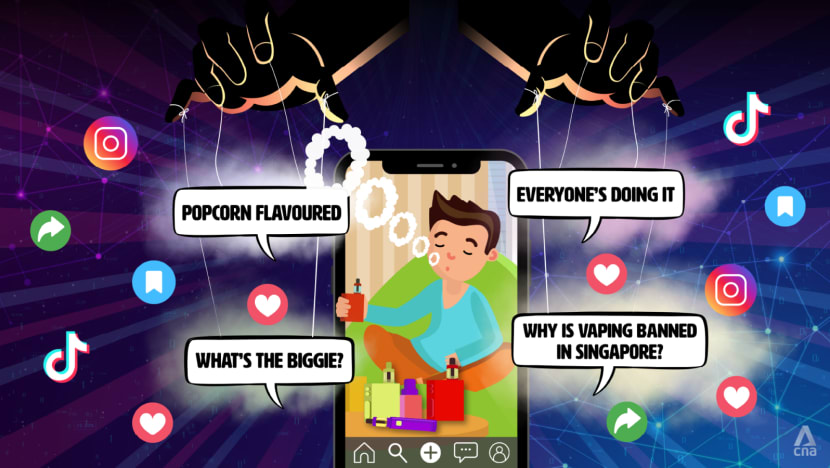Commentary: Why we should all worry about the vaping industry targeting students on social media
Despite Singapore’s vaping ban, social media is flooded with posts that make vaping appear trendy and harmless. Yvette van der Eijk of the Saw Swee Hock School of Public Health explores the industry’s role in this - and what needs to change.

The vaping industry uses social media to manipulate young people into thinking vaping is trendy and harmless. (Illustration: CNA/Clara Ho)

This audio is generated by an AI tool.
SINGAPORE: Scrolling through TikTok, a student in Singapore might stumble upon a clip of an influencer in Indonesia vaping inside a trendy cafe. On Instagram, sleek vape devices resembling tech gadgets pop up in posts, with captions celebrating flavours like “popcorn” and “grape ice”, posted by sellers in Malaysia.
“What’s the big deal?” they might wonder. “And why is this banned in Singapore?”
This is the power of social media marketing - subtle, pervasive, and, in the case of vaping, deliberately deceptive. Compounding the problem is that it’s not hard to find suppliers offering discreet delivery services to customers in Singapore.
WHY VAPING WARNINGS AREN’T STICKING
Vaping is illegal in Singapore. Outside of Singapore, vapes are also banned in more than 30 jurisdictions, while 73 countries have opted for regulation. In recent years, countries such as the United Kingdom and Australia have pursued stricter regulations due to a growing youth vaping epidemic.
Vaping comes with serious potential health risks: It is highly addictive and may cause cardiovascular disease, lung disease and cancer. Youths are particularly vulnerable, due to aggressive industry targeting.
The Singapore government has stepped up enforcement and its mass media campaigns emphasise that vaping is illegal and harmful. But that message does not seem to be resonating with Singaporean youths.
In 2024, more than 14,000 people were fined for use or possession, nearly double the previous year’s cases. In the third quarter of 2024 alone, 20 per cent (743 cases) of the offenders were students caught vaping by schools and institutes of higher learning.
Meanwhile, the narrative that seems to resonate with youths is the one pushed by Big Vape through influencers and social media - that vaping is trendy and totally harmless.
HOW THE INDUSTRY PREYS ON YOUTH
The tobacco industry, which now owns a big share of the vaping industry, has a well-documented history of targeting young people. Internal industry documents from lawsuits reveal that tobacco companies view teens, or “new smokers” as they called them, as their most important target market in Singapore.
They use subtle marketing tactics, such as movie placements, to give the impression that “everyone is doing it”. Sylvester Stallone was reportedly paid US$500,000 to smoke in five movies.
This might seem like a lot, but the companies got their return on investment. Studies estimate that 44 per cent of adolescents who start smoking do so because of smoking imagery they saw in movies.
Now that social media is the new playground, Big Tobacco/Vape has shifted its focus to platforms such as TikTok and Instagram. They pay influencers to feature vapes in their content, making it appear organic and aspirational rather than promotional.
Just last year, documents leaked by whistleblowers revealed that a major Chinese vape company, via a third party in Singapore, paid influencers to promote their vapes. They gave the influencers explicit instructions on how to bypass platform restrictions and reach its “core target audience” of 18-year-olds.
The strategy works. A recent focus group study found that, in Singapore, such content is reaching the youths and shaping their perceptions of vaping.
Influencer posts, such as selfies of people vaping by the pool, create the impression that everyone is doing it. As one focus group participant put it: “It gives the impression that more and more people are doing it. It seems to be acceptable. It’s everywhere.”
That is a stark contrast to the government’s message that vaping is illegal and harmful.
Between the two poles of “everyone is vaping” and “vaping is illegal”, social media, unfortunately, has a way of creating an alternative reality that resonates with the youths.
TIME TO #UNFOLLOWBIGVAPE
Part of the issue is that Singapore’s vaping prevention campaigns, while well-intentioned, lack the nuance to counteract industry narratives.
If a student, while waiting for the MRT, watches a TikTok clip of an influencer vaping, then looks up and sees a government poster warning that “vaping is illegal”, the messaging feels disconnected.
The missing piece is that young people often don’t realise they are being manipulated by the industry. They mistake their social media feed for reality, and dismiss government anti-vaping campaigns as biased and paternalistic.
To counter this, prevention efforts must move beyond scare tactics to educating youth on how the industry strategically markets vaping as harmless, despite evidence to the contrary. For instance, campaigns could highlight how the industry uses influencers to manipulate youths into believing that “everyone vapes”, or how they fund misleading studies that claim “vaping is safe” to discredit legitimate science.
With so much junk information out there, schools should also teach students to recognise manipulative marketing tactics, helping them discern credible information from industry-funded content.
Engagement is also key. Anti-vaping efforts need to feature relatable, engaging content on platforms where young people spend their time, like TikTok and Instagram. Peer-led campaigns featuring young advocates are far more persuasive than authority-driven warnings.
It’s time to unfollow Big Vape.
Yvette van der Eijk is Assistant Professor at the Saw Swee Hock School of Public Health, National University of Singapore.


















